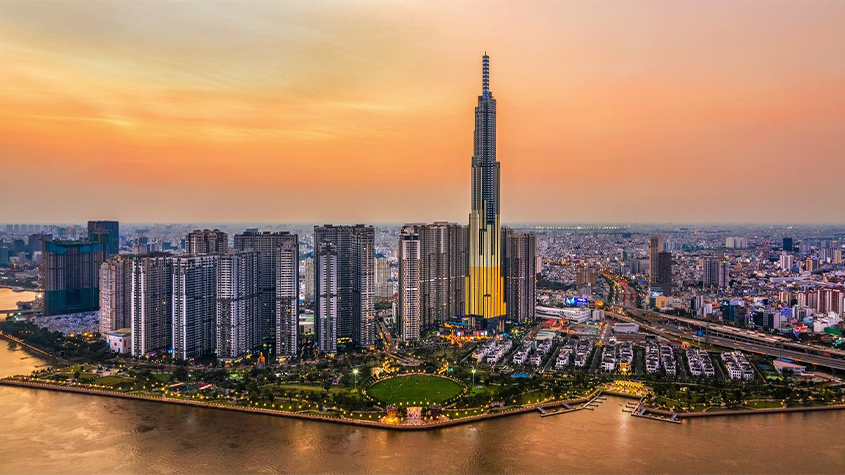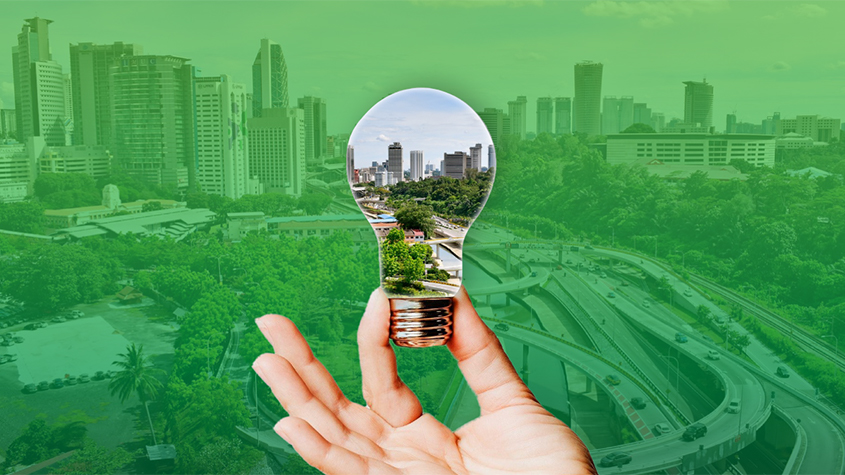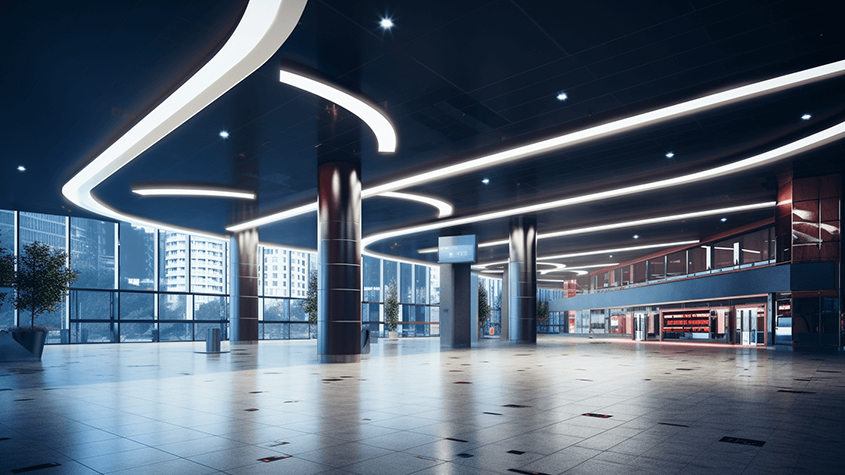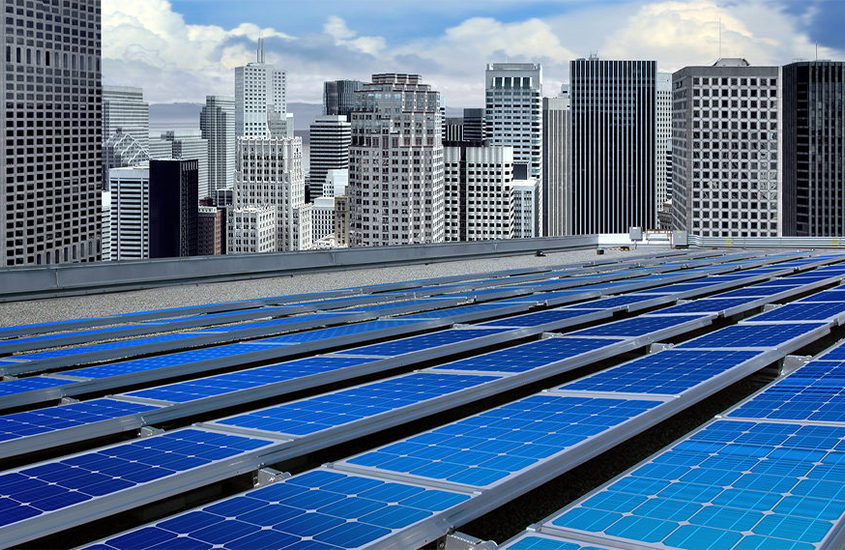Improving energy efficiency in commercial buildings has become an urgent issue in Vietnam with energy consumption demand rising rapidly. As energy costs account for a significant portion of operational expenses, implementing effective energy-saving solutions will bring considerable economic benefits. Let’s explore 10 ways to improve energy efficiency in commercial buildings in Vietnam in the article below!
State of Energy Waste in Commercial Buildings in Vietnam
The operation of commercial buildings is consuming a large amount of energy, leading to an increase in energy costs in particular and operational costs in general. According to data from Vietnam Electricity (EVN), in recent years, the energy consumption in high-rise buildings in Vietnam accounts for about 35 – 40% of the country’s total energy consumption, higher than the energy consumption of factories. Of which, air conditioning systems account for 40 – 60% of a building’s total energy consumption, lighting systems use about 15 – 20%, office equipment consumes 10 – 15%, and the remaining portion is used by other ancillary equipment. Energy waste not only creates a cost burden but also impacts the environment and energy supply.
According to a United Nations report, CO2 emissions from inefficient energy consumption in commercial buildings reached an unprecedented level of around 10 GtCO2 in 2022, an increase of about 5% compared to 2020 and 2% higher than the previous peak in 2019. This shows the significant impact of inefficient energy consumption in commercial buildings on the global environment.
However, buildings still have great potential for energy savings, especially new buildings constructed according to new energy standards or buildings that have been upgraded to optimize their systems after a period of operation. With the construction of commercial and high-rise residential projects increasing by 6 – 7% annually according to EVN, implementing energy efficiency solutions is crucial to control costs, reduce environmental impact, and ensure sustainable development.

The Importance of Improving Energy Efficiency in Commercial Buildings
Improving energy efficiency plays a crucial role in reducing operational costs and environmental impact of commercial buildings. Decreasing energy consumption allows buildings to achieve significant savings on electricity, fuel, and other utility costs, directly impacting profitability and business efficiency in a positive way. According to the U.S. Environmental Protection Agency, energy-efficient buildings typically use 25-30% less energy than conventional buildings.
Efficient energy use also helps reduce carbon emissions and other pollutants, aligning with sustainable and environmentally friendly development trends. Buildings can enhance their competitive advantage and comply with increasingly stringent environmental regulations by being energy-efficient. Many countries now offer tax incentives or other financial benefits for green, energy-efficient buildings. For example, the United States offers tax deductions for energy-efficient commercial buildings through the Energy Policy Act. Similarly, Canada provides financial incentives like grants and rebates for green buildings through programs like the Green Municipal Fund.
In particular, under The Vietnam Scaling Up Energy Efficiency Project (VSUEE) approved in 2019, industrial enterprises (IEs) and energy service companies (ESCOs) participating in energy efficiency sub-projects will receive a 50% credit guarantee for participating financial institutions (PFIs) in providing loans to the industry. At the same time, it provides funding to build capacity for private enterprises to develop and implement energy efficiency projects.
Moreover, energy-efficient buildings provide a more comfortable and healthy working environment for occupants. Temperature and air quality are better controlled, helping minimize adverse health impacts like headaches and fatigue. Improving indoor environmental quality has been linked to increased employee productivity and performance.
Therefore, developing and implementing solutions to improve energy efficiency should be considered an essential part of the sustainable development and long-term business strategy for investors as well as commercial building management units, especially in Vietnam where energy demand is rapidly increasing.

10 Ways to improve Energy Efficiency in Commercial Buildings in Vietnam
1. Conduct Energy Audits
The U.S. Environmental Protection Agency (EPA) states that around 30% of the energy consumed in commercial buildings is wasted due to various inefficiencies, like faulty electrical wires, incandescent light fixtures, refrigerant leaks, and more. According to data from the Ministry of Construction of Vietnam, approximately 40% of the total energy consumption in an urban area is energy supplied to construction projects, with high-rise buildings having the highest energy consumption index. So, the first step towards improving energy efficiency is to understand where and how energy is being consumed in a building. Professional energy audits can identify areas of inefficiency and provide recommendations for improvement.
At Vinergy, we offer a comprehensive Energy Audit solution to assist enterprises in identifying inefficiencies and unlocking opportunities to enhance energy performance within their commercial buildings. A key capability is mapping power distribution channels and identifying equipment consumption clusters to provide an installation diagram for the strategic placement of monitoring assets. With in-depth analysis of energy usage patterns and building systems, our audits can pinpoint areas with potential for savings and recommend cost-effective efficiency measures tailored to each facility’s unique needs.
2. Upgrade Lighting Systems
Lighting fixtures are an essential necessity in commercial buildings, but they can also contribute to significant energy waste. For building owners and occupants, replacing inefficient incandescent bulbs with LED lights presents an immediate and cost-effective solution to reduce energy consumption and save on utility bills. According to a study by the U.S. Department of Energy, LED lights use at least 75% less energy than conventional incandescent bulbs.
Beyond their energy-saving capabilities, LED lights offer additional advantages. They emit considerably less heat than incandescent bulbs, which can help lower air conditioning costs and reduce cooling loads within the building. LED lights also provide brighter, more uniform illumination, contributing to improved occupant comfort and potentially boosting employee productivity.

3. Optimize HVAC Systems
According to statistics from the Ho Chi Minh City Energy Conservation Center, for office buildings serving as administrative headquarters, the equipment that consumes the most energy is air conditioning, accounting for over 70% of total energy use. Therefore, it can be said that HVAC is one of the highest energy-consuming areas in a building.
According to the International Energy Agency (IEA), optimizing the HVAC system can help save 20% to 40% of the energy used for cooling and heating. Optimizing and properly maintaining the system can lead to significant energy and cost savings, for example by installing high-efficiency heating and cooling systems, such as condensing boilers, heat pumps, or variable refrigerant flow (VRF) systems.
4. Improve Insulation
Poor insulation leads to increased demand for HVAC usage to maintain indoor temperatures. According to research by the Vietnam Energy Institute, proper insulation for walls and roofs can help reduce the need for air conditioning by 20% to 30%, resulting in significant energy savings. The Ministry of Construction estimates that improved insulation measures can help reduce a building’s total energy costs by 5% to 10%. Insulating materials that can help save heating and cooling costs include house wraps and sealed coating. Insulation work in existing buildings is not just for walls; windows, doors, and roofs also need to be sealed to prevent air leakage.
5. Utilize Daylight
Utilizing natural daylight from the sun through proper window design and placement helps reduce the need for artificial lighting and saves energy. Studies have shown that increasing natural light can decrease the demand for artificial lighting by around 16 – 20% (Velux, 2018). According to the Vietnam Green Building Council (VGBC), in most constructions that incorporate natural daylighting systems, the overall energy savings range from 15 – 40%. Furthermore, office high-rises have recorded energy savings from using natural light ranging from 20 – 60%.
6. Buy Energy Certified Equipment
For owners of commercial buildings, transitioning to energy-efficient systems presents an opportunity to dramatically reduce heating and cooling expenditures. The Energy Star certification program, endorsed by the Department of Energy, serves as a reliable guide for identifying trusted, energy-saving equipment and appliances on the market. Spanning from computers to HVAC systems, Energy Star certified products consume between 30% and 65% less energy compared to their non-certified counterparts.
7. Pursue Green Building Certifications
Green building certification programs like LEED and EDGE have stringent standards for energy efficiency and minimizing environmental impact. According to the U.S. Green Building Council, LEED-certified projects divert over 80 million tons of waste away from landfills. The U.S. General Services Administration states that LEED Gold buildings in their portfolio consume 25% less energy and produce 34% fewer greenhouse gas emissions compared to the national average.
While achieving compliance can increase upfront costs for construction and renovations, LEED offers excellent opportunities for long-term cost savings. Utilizing LEED’s energy benchmarks for mechanical systems and energy conservation allows you to recoup your investment within just a few years through reduced utility expenditures.
8. Utilize Renewable Energy Sources
Integrating renewable energy sources such as solar and wind power into a building’s system is an effective solution to reduce dependence on the national grid and traditional fossil fuels. According to energy experts, installing rooftop solar systems can meet a considerable portion of the energy needs of a commercial building. The Vietnam Energy Institute also estimates that small-scale wind turbines can provide a certain amount of electricity when wind conditions are favorable.
In addition to the positive environmental impact of reducing carbon emissions and air pollutants, using renewable energy helps create a sustainable, safe, and reliable energy source for the building’s operations, while also reducing long-term energy costs.

9. Regularly Maintain and Upgrade equipment
Regular maintenance and upgrading of equipment is absolutely necessary. Periodic maintenance of equipment such as air conditioning systems, generators, and lighting fixtures helps ensure they operate efficiently, avoiding energy waste. According to the report “Improving Energy Efficiency in Commercial Buildings in Vietnam” by the Vietnam Energy Institute in 2021, periodic maintenance of air conditioning systems can help save 10 – 15% of energy consumption.
10. Implement Energy Monitoring and Management Systems
For commercial buildings, controlling and optimizing energy usage is a crucial issue to save operational costs while contributing to environmental protection. Implementing an Energy Monitoring System(EMS) is a comprehensive solution that allows you to monitor, control, and optimize energy usage throughout the entire building through automation and intelligent control.
With the support of Vinergy, you will enjoy practical benefits such as the installation of sensors, meters, and real-time energy data analysis software; automated control of air conditioning systems with a team of experts providing strategic consultation on energy-saving optimization; and periodic evaluations of energy efficiency. Contact Vinergy now for a free consultation on the most suitable solution for your building!
